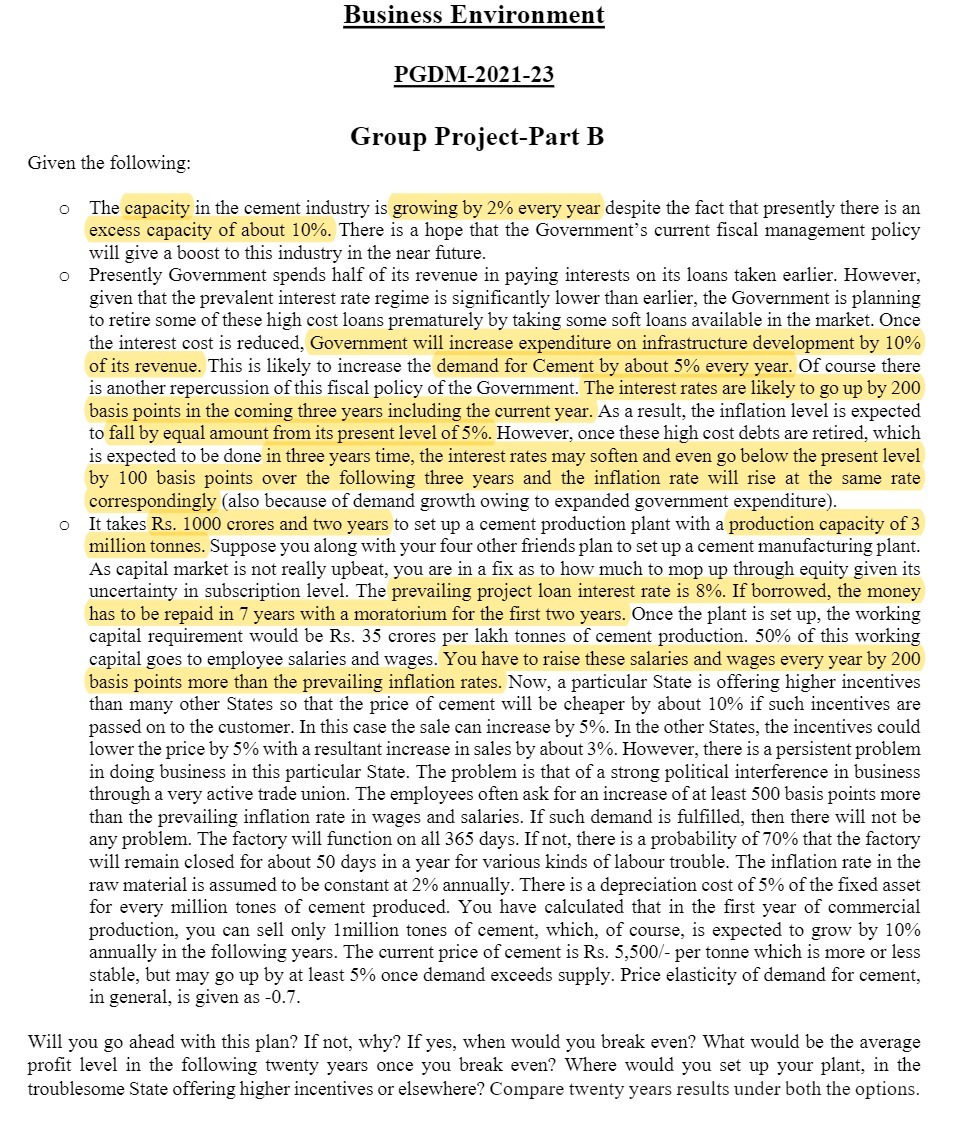Business Environment PGDM202123 Group ProjectPart B Given the following: o The capacity in the cement industry is growing by 2% every year despite the fact that presently there is an excess capacity of about 10%. There is a hope that the Govemment's current scal management policy will give a boost to this industry in the near future. 0 Presently Government spends half of its revenue in paying interests on its loans taken earlier. However, given that the prevalent interest rate regime is signicantly lower than earlier, the Government is planning to retire some of these high cost loans prematurely by taking some soft loans available in the market. Once the interest cost is reduced, Government will increase expenditure on infrastructure development by 10% of its revenue. This is likely to increase the demand for Cement by about 5% every year. Of course there is another repercussion of this scal policy of the Government. The interest rates are likely to go up by 200 basis points in the coming three years including the current year. As a result, the ination level is expected to fall by equal amount om its present level of 5%. However, once these high cost debts are retired, which is expected to be done in three years time, the interest rates may soften and even go below the present level by 100 basis points over the following three years and the ination rate will rise at the same rate correspondingly (also because of demand growth owing to expanded government expenditure). 0 It takes Rs. 1000 crores and two years to set up a cement production plant with a production capacity of 3 million tonnes. Suppose you along with your four other iends plan to set up a cement manufacturing plant. As capital market is not really upbeat, you are in a x as to how much to mop up through equity given its uncertainty in subscription level. The prevailing project ioan interest rate is 3%. Ifborrowed, the money has to be repaid in 7 years with a moratorium for the rst two years. Once the plant is set up, the working capital requirement would be Rs. 35 crores per lakh tonnes of cement production. 50% of this working capital goes to employee salaries and wages. You have to raise these salaries and wages every year by 200 basis points more than the prevailing ination rates. Now, a particular State is offering higher incentives than many other States so that the price of cement will be cheaper by about 10% if such incentives are passed on to the customer. in this case the sale can increase by 5%. In the other States, the incentives could lower the price by 5% with a resultant increase in sales by about 3%. However, there is a persistent problem in doing business in this particular State. The problem is that of a strong political interference in business through a very active trade union. The employees often ask for an increase of at least 500 basis points more than the prevailing ination rate in wages and salaries. If such demand is fulfilled, then there will not be any problem. The factory will function on all 365 days. [fnot, there is a probability of 70% that the factory will remain closed for about 50 days in a year for various kinds of labour trouble. The ination rate in the raw material is assumed to be constant at 2% annually. There is a depreciation cost of 5% of the fixed asset for every million tones of cement produced. You have calculated that in the rst year of commercial production, you can sell only lmillion tones of cement, which, of course, is expected to grow by 10% annually in the following years. The current price of cement is Rs. 5,500.!\"- per tonne which is more or less stable, but may go up by at least 5% once demand exceeds supply. Price elasticity of demand for cement, in general, is given as 0.7. Will you go ahead with this plan? If not, why? If yes, when would you break even? What would be the average prot level in the following twenty years once you break even? \"here would you set up your plant, in the troublesome State oering higher incentives or elsewhere? Compare twenty years results under both the options







